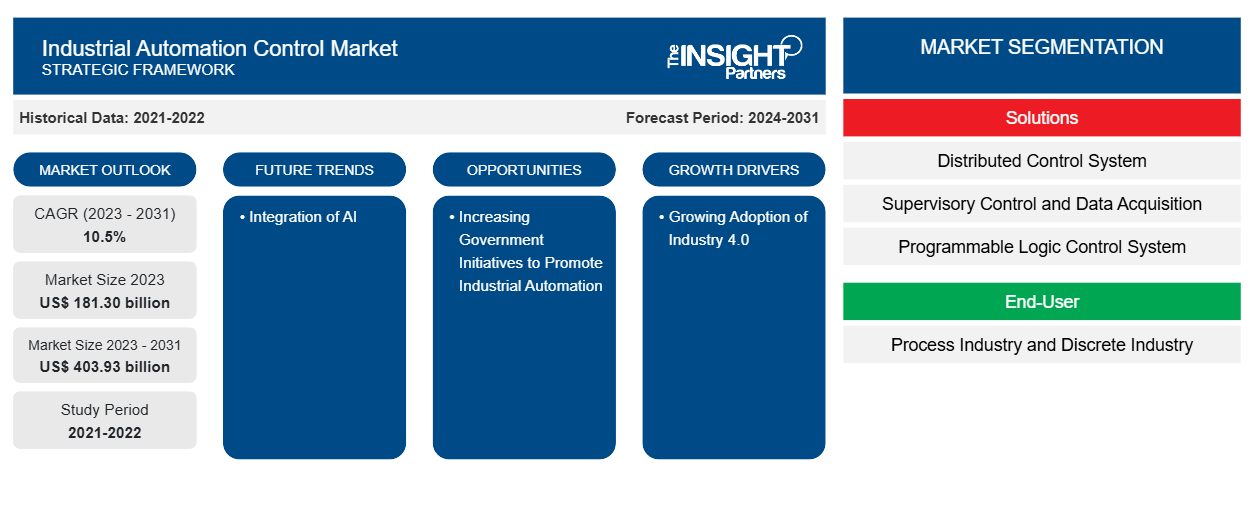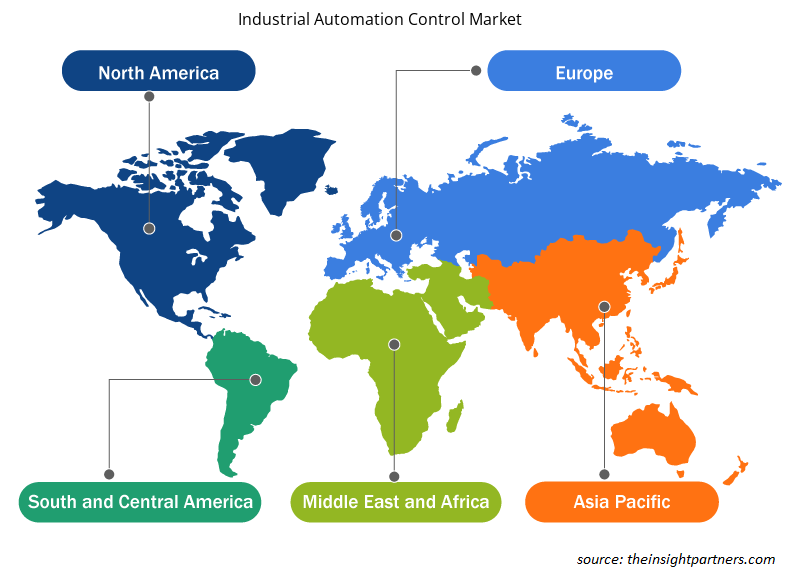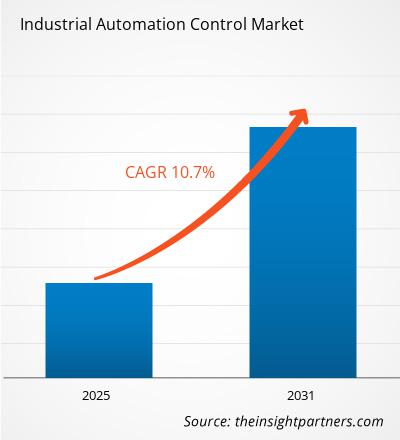预计到2031年,工业自动化控制市场规模将从2024年的1932.2亿美元增至3916.3亿美元。预计2025年至2031年期间,该市场的复合年增长率将达到10.7%。人工智能(AI)和机器学习(ML)的融合可能会在未来几年为市场带来新的趋势。
工业自动化控制市场分析
制造业自动化涵盖了从控制装配线和包装流程到监督精密加工或化工生产等复杂任务等一系列应用。通过实时数据收集和分析,自动化系统可以检测故障、预测维护需求并优化工作流程,从而减少故障和停机时间。这带来了更敏捷的生产环境,使其能够快速响应市场变化或消费者需求。通过减少人为错误并加强运营监督,工业自动化控制在提高工作场所安全性方面也发挥着关键作用。对于企业而言,它可以显著节省成本、缩短生产周期,并更有效地扩展运营规模。随着各行各业持续采用自动化技术,它们可以实现更高的竞争力和创新水平,从而在日益数字化和全球化的市场中占据长期增长和成功的优势。
工业自动化控制市场概况
工业自动化控制是指利用先进的技术和控制系统(例如计算机、机器人和信息系统)来管理和监控工业流程和机械设备。工业自动化控制的目标是通过减少制造过程中的人为干预来提高效率、生产力和安全性。在商业领域,工业自动化控制通过自动化重复且耗时的任务来简化生产流程,从而实现更快、更准确、更一致的输出。通过自动化,企业可以提高运营效率、降低错误风险并最大限度地降低人工成本,同时保持高水平的产品质量。这些系统通常集成传感器、机器人和人工智能 (AI),以实时监控和控制生产线,并进行调整以提高性能并减少浪费。
定制此报告以满足您的要求
您可以免费定制任何报告,包括本报告的部分内容、国家级分析、Excel 数据包,以及为初创企业和大学提供优惠和折扣
工业自动化控制市场:战略洞察

- 获取此报告的顶级关键市场趋势。此免费样品将包括数据分析,从市场趋势到估计和预测。
工业自动化控制市场驱动因素和机遇
工业自动化控制在各行各业的广泛应用
工业自动化控制在汽车以外的其他行业的渗透速度正在加快。近年来,非汽车行业的渗透率远低于汽车行业。随着工业机器人等设备功能的不断增强,预计非汽车行业将进一步加速工业自动化控制的采用。underpenetrated in comparison to the automotive industry. With the increasing functionality of equipment such as industrial
除了工业领域,各国之间的渗透率也在不断提升。包括中国、美国和日本在内的发达市场渗透率更高;然而,即使在发达市场,工业市场仍有巨大的增长空间。例如,2023年,中国占全球总产值的35%,几乎是美国的三倍,位居第二,占比12%。在这些国家中,尤其是在非汽车行业,进一步安装的前景令人瞩目。这种增长归功于这些市场所需的现代化和转型。这些数据对制造商来说充满希望,因为它预示着应用率的进一步提升的巨大空间。
政府支持增加
随着全球各行各业努力提高效率、简化制造流程,政府和政策制定者在推动工业自动化控制方面的重要性日益凸显。工业自动化控制在推动第四次工业革命中发挥着关键作用,各国政府和政策制定者需要建立适当的支持机制和监管框架,以促进其广泛应用和发展。例如,印度政府已实施多项措施加强智能制造业,其中一项关键举措是“生产挂钩激励计划”(PLI)。PLI计划于2020年启动,涵盖汽车、制药、纺织、食品加工和白色家电等14个行业,是其促进国内制造业发展的更广泛战略的一部分。该计划旨在通过向在本地生产并符合特定投资、销售和出口标准的企业提供财政激励,鼓励企业采用智能制造实践。该计划旨在增强这些企业的竞争力,进而提升印度制造业的整体价值。
同样,在美国,2023 年,能源部 (DoE) 宣布了一项 2200 万美元的计划,支持 12 个州立项目,以加快中小型工厂采用智能制造。这项由总统的两党基础设施法资助的计划旨在提高美国制造业获得智能制造技术和高性能计算的机会。此外,2023 年 8 月,先进制造机器人 (ARM) 研究所入围了八个新的短周期技术项目,并计划通过其 23-01 技术项目征集提供总计约 326 万美元的资助。预计这些举措将为促进智能制造业的发展提供重要机遇,从而推动工业自动化控制市场的增长。
工业自动化控制市场报告细分分析
有助于得出工业自动化控制市场分析的关键部分是系统和最终用户。
- 根据系统类型,工业自动化控制市场可细分为SCADA、DCS、PLC、PLM等。SCADA领域在2024年占据市场主导地位。
- 根据最终用户,工业自动化控制市场可分为过程工业和离散工业。离散工业将在2024年占据市场主导地位。
工业自动化控制市场份额(按地区)分析
工业自动化控制市场分为五大区域:北美、欧洲、亚太地区、中东和非洲(MEA)以及南美。2024年,北美占据了市场主导地位。
在整个北美,技术进步催生了高度竞争的市场,使该地区成为创新和经济实力的中心。该地区的企业正在持续优化业务流程,以最高效的方式满足日益增长的高质量产品和服务需求。
全球企业正在实施各种举措,以进一步推动工业自动化控制市场的增长。例如,2024年12月,ONDEX Automation(简称“ONDEX”或“公司”)宣布已与总部位于新泽西州穆尔斯敦的控制系统和工业自动化服务领导者 Automation & Control Inc.(简称“ACI”)达成合作。此次战略合作标志着 ONDEX Automation 为北美制造业客户提供创新自动化解决方案的使命迈出了重要的一步。在芝加哥私募股权公司 Shore Capital Partners 的支持下,ONDEX Automation 正在打造一家领先的系统集成商,以满足其北美制造业客户的需求。ONDEX 正在积极寻求更多机会,与拥有多元化能力、经验丰富的工程人才以及对创新和卓越的共同承诺的工厂自动化系统集成商合作。北美工业自动化控制市场的主要参与者包括罗克韦尔自动化公司、ABB 有限公司和三菱电机株式会社。这些公司正在推动创新,并塑造该地区工业自动化的未来。
工业自动化控制市场区域洞察
Insight Partners 的分析师已详尽阐述了预测期内影响工业自动化控制市场的区域趋势和因素。本节还讨论了北美、欧洲、亚太地区、中东和非洲以及南美和中美洲的工业自动化控制市场细分和地域分布。

- 获取工业自动化控制市场的区域特定数据
工业自动化控制市场报告范围
| 报告属性 | 细节 |
|---|---|
| 2024年的市场规模 | 1932.2亿美元 |
| 2031年的市场规模 | 3916.3亿美元 |
| 全球复合年增长率(2025-2031) | 10.7% |
| 史料 | 2021-2023 |
| 预测期 | 2025-2031 |
| 涵盖的领域 | 按系统
|
| 覆盖地区和国家 | 北美
|
| 市场领导者和主要公司简介 |
|
工业自动化控制市场参与者密度:了解其对业务动态的影响
工业自动化控制市场正在快速增长,这得益于终端用户需求的不断增长,而这些需求又源于消费者偏好的不断变化、技术进步以及对产品优势的认知度不断提升等因素。随着需求的增长,企业正在扩展产品线,不断创新以满足消费者需求,并抓住新兴趋势,从而进一步推动市场增长。
市场参与者密度是指特定市场或行业内企业或公司的分布情况。它表明特定市场空间内竞争对手(市场参与者)的数量相对于其规模或总市值而言。
在工业自动化控制市场运营的主要公司有:
- ABB有限公司
- 霍尼韦尔国际公司
- 西门子股份公司
- 艾默生电气公司
- 博世力士乐股份公司
- 通用电气公司
免责声明:以上列出的公司没有按照任何特定顺序排列。

- 获取工业自动化控制市场顶级关键参与者概览
工业自动化控制市场新闻和最新发展
工业自动化控制市场的评估是通过收集一手和二手资料后进行的定性和定量数据进行的,这些数据包括重要的企业出版物、协会数据和数据库。以下列出了工业自动化控制市场的一些发展情况:
- 博世力士乐正在通过两种新解决方案扩展其在自动化领域的 BODAS 生态系统:防撞系统通过使用雷达、超声波和智能摄像头进行精确的物体检测和人员检测,实现有效的防撞。
(来源:博世力士乐,新闻稿,2025 年)
- ABB 推出了 ABB Ability Symphony Plus SDe 系列硬件产品,旨在帮助工厂实现现有过程控制系统的现代化升级,最大程度降低风险并最大程度地减少对工厂运营的干扰。新系列产品使电力、水务、石油天然气、制药以及纸浆造纸等行业的工厂运营商能够将现有的控制系统升级到最新技术,从而提高效率和生产力。
(来源:ABB,新闻稿,2024 年)
工业自动化控制市场报告覆盖范围和交付成果
“工业自动化控制市场规模和预测(2021-2031)”对以下领域进行了详细的市场分析:
- 工业自动化控制市场规模以及全球、区域和国家层面涵盖的所有关键细分市场的预测
- 工业自动化控制市场趋势以及市场动态,如驱动因素、限制因素和关键机遇
- 详细的 PEST 和 SWOT 分析
- 工业自动化控制市场分析涵盖主要市场趋势、全球和区域框架、主要参与者、法规和最新市场发展
- 行业格局和竞争分析,涵盖市场集中度、热图分析、知名参与者以及工业自动化控制市场的最新发展
- 详细的公司简介
- 历史分析(2 年)、基准年、预测(7 年)及复合年增长率
- PEST和SWOT分析
- 市场规模、价值/数量 - 全球、区域、国家
- 行业和竞争格局
- Excel 数据集
近期报告
客户评价
购买理由
- 明智的决策
- 了解市场动态
- 竞争分析
- 客户洞察
- 市场预测
- 风险规避
- 战略规划
- 投资论证
- 识别新兴市场
- 优化营销策略
- 提升运营效率
- 顺应监管趋势




















 获取免费样品 - 工业自动化控制市场
获取免费样品 - 工业自动化控制市场